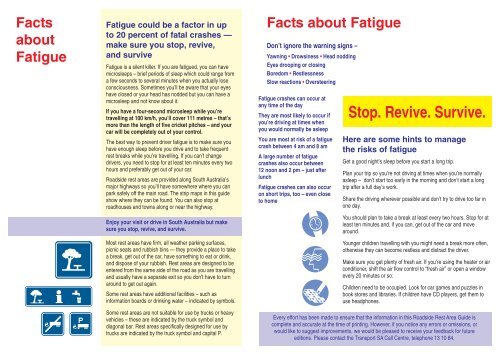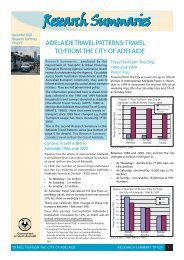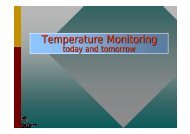Stop. Revive. Survive. - Transport SA
Stop. Revive. Survive. - Transport SA
Stop. Revive. Survive. - Transport SA
Create successful ePaper yourself
Turn your PDF publications into a flip-book with our unique Google optimized e-Paper software.
Facts<br />
about<br />
Fatigue<br />
Fatigue could be a factor in up<br />
to 20 percent of fatal crashes —<br />
make sure you stop, revive,<br />
and survive<br />
Fatigue is a silent killer. If you are fatigued, you can have<br />
microsleeps – brief periods of sleep which could range from<br />
a few seconds to several minutes when you actually lose<br />
consciousness. Sometimes you’ll be aware that your eyes<br />
have closed or your head has nodded but you can have a<br />
microsleep and not know about it.<br />
If you have a four-second microsleep while you’re<br />
travelling at 100 km/h, you’ll cover 111 metres – that’s<br />
more than the length of five cricket pitches – and your<br />
car will be completely out of your control.<br />
The best way to prevent driver fatigue is to make sure you<br />
have enough sleep before you drive and to take frequent<br />
rest breaks while you’re travelling. If you can’t change<br />
drivers, you need to stop for at least ten minutes every two<br />
hours and preferably get out of your car.<br />
Roadside rest areas are provided along South Australia’s<br />
major highways so you’ll have somewhere where you can<br />
park safely off the main road. The strip maps in this guide<br />
show where they can be found. You can also stop at<br />
roadhouses and towns along or near the highway.<br />
Enjoy your visit or drive in South Australia but make<br />
sure you stop, revive, and survive.<br />
Most rest areas have firm, all weather parking surfaces,<br />
picnic seats and rubbish bins — they provide a place to take<br />
a break, get out of the car, have something to eat or drink,<br />
and dispose of your rubbish. Rest areas are designed to be<br />
entered from the same side of the road as you are travelling<br />
and usually have a separate exit so you don’t have to turn<br />
around to get out again.<br />
Some rest areas have additional facilities – such as<br />
information boards or drinking water – indicated by symbols.<br />
Some rest areas are not suitable for use by trucks or heavy<br />
vehicles – these are indicated by the truck symbol and<br />
diagonal bar. Rest areas specifically designed for use by<br />
trucks are indicated by the truck symbol and capital P.<br />
Facts about Fatigue<br />
Don’t ignore the warning signs –<br />
Yawning Drowsiness Head nodding<br />
Eyes drooping or closing<br />
Boredom Restlessness<br />
Slow reactions Oversteering<br />
Fatigue crashes can occur at<br />
any time of the day<br />
They are most likely to occur if<br />
you’re driving at times when<br />
you would normally be asleep<br />
You are most at risk of a fatigue<br />
crash between 4 am and 8 am<br />
A large number of fatigue<br />
crashes also occur between<br />
12 noon and 2 pm – just after<br />
lunch<br />
Fatigue crashes can also occur<br />
on short trips, too – even close<br />
to home<br />
<strong>Stop</strong>. <strong>Revive</strong>. <strong>Survive</strong>.<br />
Here are some hints to manage<br />
the risks of fatigue<br />
Get a good night’s sleep before you start a long trip.<br />
Plan your trip so you’re not driving at times when you’re normally<br />
asleep – don’t start too early in the morning and don’t start a long<br />
trip after a full day’s work.<br />
Share the driving wherever possible and don’t try to drive too far in<br />
one day.<br />
You should plan to take a break at least every two hours. <strong>Stop</strong> for at<br />
least ten minutes and, if you can, get out of the car and move<br />
around.<br />
Younger children travelling with you might need a break more often,<br />
otherwise they can become restless and distract the driver.<br />
Make sure you get plenty of fresh air. If you’re using the heater or air<br />
conditioner, shift the air flow control to “fresh air” or open a window<br />
every 20 minutes or so.<br />
Children need to be occupied. Look for car games and puzzles in<br />
book stores and libraries. If children have CD players, get them to<br />
use headphones.<br />
Every effort has been made to ensure that the information in this Roadside Rest Area Guide is<br />
complete and accurate at the time of printing. However, if you notice any errors or omissions, or<br />
would like to suggest improvements, we would be pleased to receive your feedback for future<br />
editions. Please contact the <strong>Transport</strong> <strong>SA</strong> Call Centre, telephone 13 10 84.
International Visitors ...<br />
please take special care<br />
on country roads<br />
Crashes involving international visitors tend<br />
occur in rural areas and are often more seve<br />
than crashes involving local road users.<br />
Most of our visitors come from countries<br />
which drive on the same side of the road<br />
we do but almost one third are accustome<br />
driving on the right.<br />
Driver <strong>Revive</strong>r<br />
is a national campaign which encourages<br />
drivers to take regular rest breaks when<br />
travelling.<br />
Driver <strong>Revive</strong>r sites operate in South<br />
Australia during school holiday periods as<br />
part of the longest running and most<br />
extensive campaign of this type in Australia<br />
The sites provide a welcome break from<br />
driving, and free coee, tea and a biscuit f<br />
travellers.<br />
Driver <strong>Revive</strong>r sites are supported by<br />
volunteers from a range of community<br />
groups.
Leave no trace<br />
Always carry a car tidy bag when you’re<br />
travelling.Dispose of litter responsibly. Use<br />
a bin or, better still, please take your litter<br />
away with you even if a bin is provided.<br />
If you are a smoker, please use your<br />
vehicle ash tray and dispose of your<br />
cigarette butts properly – they can cause<br />
res and are very dangerous to animals<br />
when ingested.<br />
Protect roadside vegetation. Many rare<br />
and threatened species can now only be<br />
found on our roadside verges. The key<br />
principle for protecting vegetation around res<br />
stop areas is to minimise disturbance. Avoid<br />
damaging trees and shrubs and any tracks<br />
you drive over (even dead wood lying around<br />
can be home to native insects and animals).<br />
Vehicle exhausts are a potential re<br />
hazard. Avoid parking on roadside areas<br />
that are grassed.<br />
Toilet paper litter mucks it up for<br />
everyone.If toilet facilities are not available<br />
and you get caught short while travelling –<br />
bury it. Carry a metal shovel and bury all<br />
faecal waste and paper. Carry out sanitary<br />
items and disposable nappies – they don’t<br />
degrade because of their plastic liners.<br />
You can make a dierence. If you come<br />
across someone else's rubbish, give<br />
something back to our fragile environment –<br />
carry that out too!




